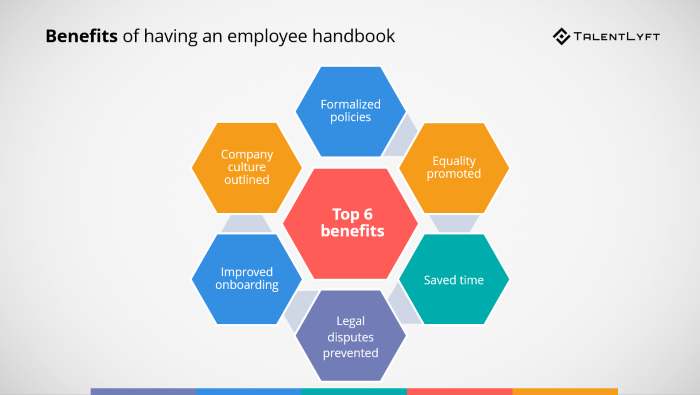
Articles
How to Create a Company Policy Handbook: A Basic Guide

Do you need to learn how to create a company policy handbook that will help your business scale and grow? Whether it's onboarding, offboarding, or training employees on company policies, having a comprehensive guide is essential.
But where do you start with creating such an important document? In this blog post, we'll explore the key steps for defining your company policies, creating your policy handbook, and ensuring compliance with these rules. So let's learn together how to create a company policy handbook.
Defining Your Company Policies
Company regulations that direct how an enterprise is conducted are known as company policies. They define acceptable behavior, outline responsibilities, and provide guidance on what is expected of employees in various situations.
For businesses with 25 to 100 employees, a policy handbook is an invaluable resource for both managers and staff members alike in understanding their roles within the organization. It serves as a reference guide for both managers and staff members alike, ensuring everyone understands their roles within the company. This is why it's important to learn how to create a company policy handbook.
It's wise to ensure your policy handbook includes sections on:
- Harassment prevention training requirements.
- Diversity initiatives.
- Compensation guidelines.
- Performance reviews.
- Drug testing protocols.
- Social media use expectations.
- Attendance policies and other topics specific to your organization or industry.
- Employee conduct.
- Job duties.
- Safety procedures.
- Vacation policies and benefits programs.
- Dispute resolution processes.
With this in-depth coverage of key issues, you can provide a comprehensive reference guide for both managers and staff members alike. This ensures everyone understands their roles within the company.
You must make sure all applicable laws are adhered to when creating your policy handbook, so be sure to consult with legal counsel if needed before finalizing it for distribution among staff members.
Your goal should be clear communication between management and staff. Keep the language simple yet comprehensive enough that everyone can understand exactly what is expected of them at work each day without confusion or ambiguity about the rules they must follow while employed by your company.
Having a clear understanding of what company policies are and why they're necessary is the foundation for creating an effective policy handbook.
How to Create a Company Policy Handbook
Learning how to create a policy handbook is an essential part of running a successful business. A policy handbook is a must for any prosperous business, acting as the basis of how personnel should behave and what to do in different circumstances.
Outline and Draft the Employee Handbook
To get started, you need to first outline the structure of your employee handbook. This includes deciding which topics will be covered and their order of appearance.
When drafting the content of your policy handbook, make sure it's clear and concise yet comprehensive enough to cover all relevant areas. Additionally, consider including examples that help illustrate each point or scenario more effectively.
You can also add keywords throughout so readers can quickly find what they're looking for when referencing back at a later date.
Beta-test the Employee Manual
Once you have written a draft of the employee manual, gather an ad hoc committee of employees to gain feedback. This ad hoc committee's role is to review the draft, give pointers for improvement, and pose questions.
The output from the initial review will serve as the guide for revision when creating employee handbooks.

Publish the Employee Handbooks
When you've got all the elements for your policy manual compiled, it's time to seal and publish. Make sure all information is up-to-date and accurate before distributing it among staff members — no one likes outdated policies.
Once finalized, decide how best to share with employees. This could include via email or printed copies during onboarding sessions or training seminars.
Learning how to create a company policy handbook doesn't have to be daunting if done right from the start. Just keep in mind that having clear rules makes everyone’s job easier. So take some time upfront outlining exactly what needs to go into yours and make sure every detail is accounted for, it will pay off in the long run.
Developing a policy manual is vital for making sure personnel comprehend and comply with business regulations. By training employees on these policies, you can ensure a better understanding of the expectations for each employee.
Training Employees on Company Policies
When it comes to training employees on company policies, it’s important to ensure that everyone is on the same page. Introducing new regulations can be difficult, but with the right techniques and strategies, you can guarantee your staff comprehends what is anticipated of them. Here are some tips for effective policy training.
Explain the Rationale
Explain the rationale for new policies and provide practical examples to foster buy-in from employees. This helps create buy-in from your team and encourages their compliance with those rules. Additionally, if possible, provide real-world examples or scenarios that illustrate how these policies apply in everyday situations.
Make the Trainings Interactive
Second, keep your policy training interactive and engaging by using different teaching methods such as role-playing exercises or group activities. This will help reinforce understanding of key concepts while also keeping things interesting for participants.
Finally, don’t forget about follow-up sessions where you review any questions or areas of confusion that may have come up during initial training sessions. This way, everyone leaves feeling confident in their knowledge of company policies and procedures.
Evaluate Understanding
Lastly, evaluate employee understanding of company policies by providing quizzes or surveys after each session. This allows you to measure comprehension levels and identify any areas where additional clarification may be needed before moving forward with implementation plans.
You should also consider having an open forum where employees can ask questions without fear of judgment. This provides an opportunity for candid dialogue which often leads to deeper insights into how people perceive certain topics related to corporate governance guidelines.
Training employees on company policies is an essential part of any successful business, as it ensures that all staff members understand and adhere to the rules. To guarantee observance of the regulations, setting up an internal system for tracking them is essential.
Ensuring Compliance with Company Policies
Establishing an Internal Compliance System
To ensure that all policies are adhered to, a company must have an established internal compliance system. This should include procedures and protocols for identifying, assessing, managing, monitoring and reporting risks associated with the organization’s policies.
Additionally, it should also outline how employees are expected to adhere to these policies. A good internal compliance system can help ensure that everyone is on the same page when it comes to understanding their responsibilities regarding company policy.
Auditing and Monitoring Compliance with Company Policies
Once you have established your internal compliance system, regular audits of employee behavior must be conducted to identify areas where additional training or disciplinary action may be needed. These audits should focus on specific activities such as attendance records, customer service interactions, safety regulations, and adherence.
This will allow managers to gain insight into whether or not employees are following company policy correctly. Periodic polls may also be employed to measure staff comprehension of their duties within the business and if they comprehend what is anticipated from them by corporate regulations.
Corrective Action
In some cases, it may become necessary for management or HR personnel to take corrective action when an employee fails to comply with company policy despite multiple warnings or attempts at providing additional training opportunities. Depending on the gravity of the offense, corrective action may involve suspension without pay or termination. All corrective actions taken against employees must follow legal guidelines set out by labor laws and other relevant regulations to avoid any potential lawsuits related thereto.
Conclusion
Learning how to create a company policy handbook helps ensure compliance with policies, provides clarity and consistency in training employees and allows the organization to document its processes.
Investing time into creating employee handbooks will ultimately help businesses grow and scale while providing superior onboarding, offboarding, and training experiences.
Are you an entrepreneur, founder, manager, or operational leader looking to scale your business? Trainual is here to help! Our business playbook software is designed to provide superior onboarding, offboarding, and employee training experiences.
We'll ensure that your team members have the knowledge they need for success while streamlining processes and policies. With our customizable solution tailored specifically for you, take control of your organization today with Trainual's top-notch services.
Similar Blog Posts







